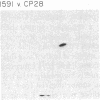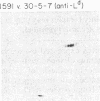Abstract
Two novel class I-like molecules expressed on tumor 1591, a C3H UV-induced fibrosarcoma, are biochemically characterized using two-dimensional gel electrophoresis, a cross-blocking RIA, and tryptic peptide mapping. One novel molecule that reacts with CP28, a syngeneic tumor-specific monoclonal antibody, appears mosaic because it possesses characteristics of both Kk and Dk class I molecules. The second molecule is closely related but not identical to the bona fide Ld molecule expressed on BALB/c spleen. Thus 1591 expresses at least two novel class I molecules and is vigorously rejected by normal C3H mice, while a variant tumor derived from 1591, termed AS7, does not express these two class I molecules although it still expresses Kk and Dk. The significance of these observations to the immunobiology and genetics of the UV-induced fibrosarcoma system is discussed. Speculations on the role that the major histocompatibility complex may play in the immunosurveillance of neoplasms are also presented.
Full text
PDF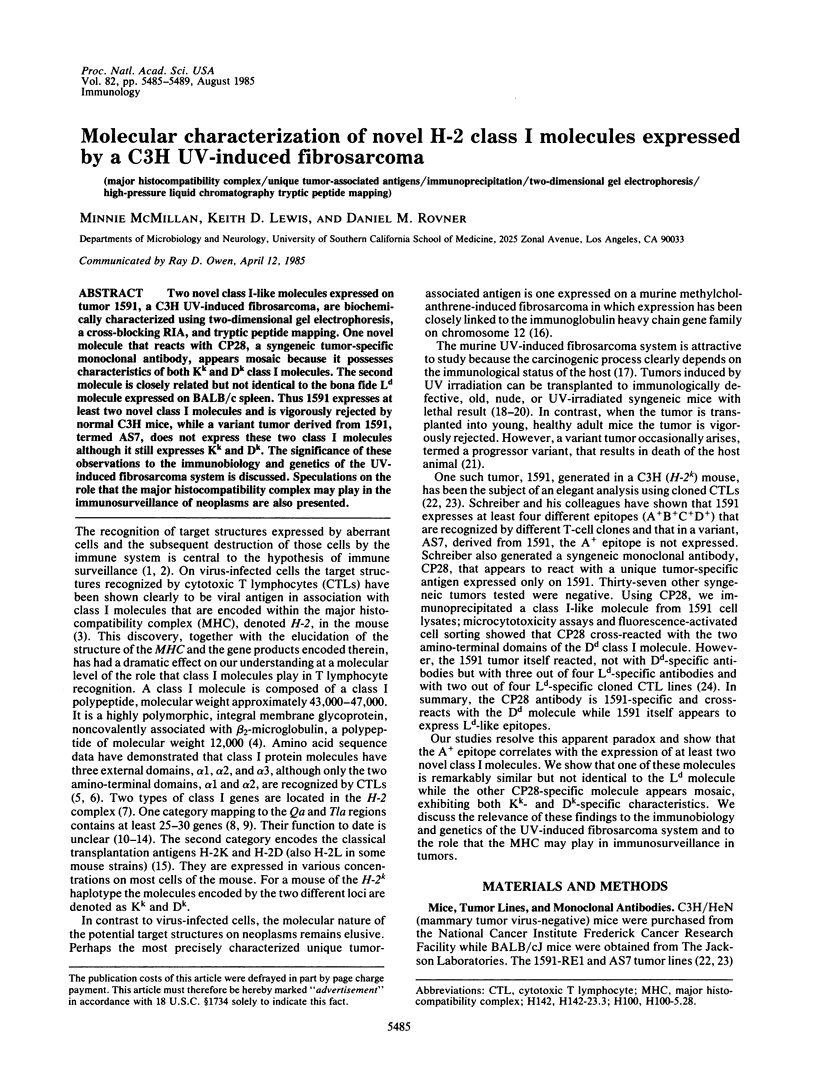
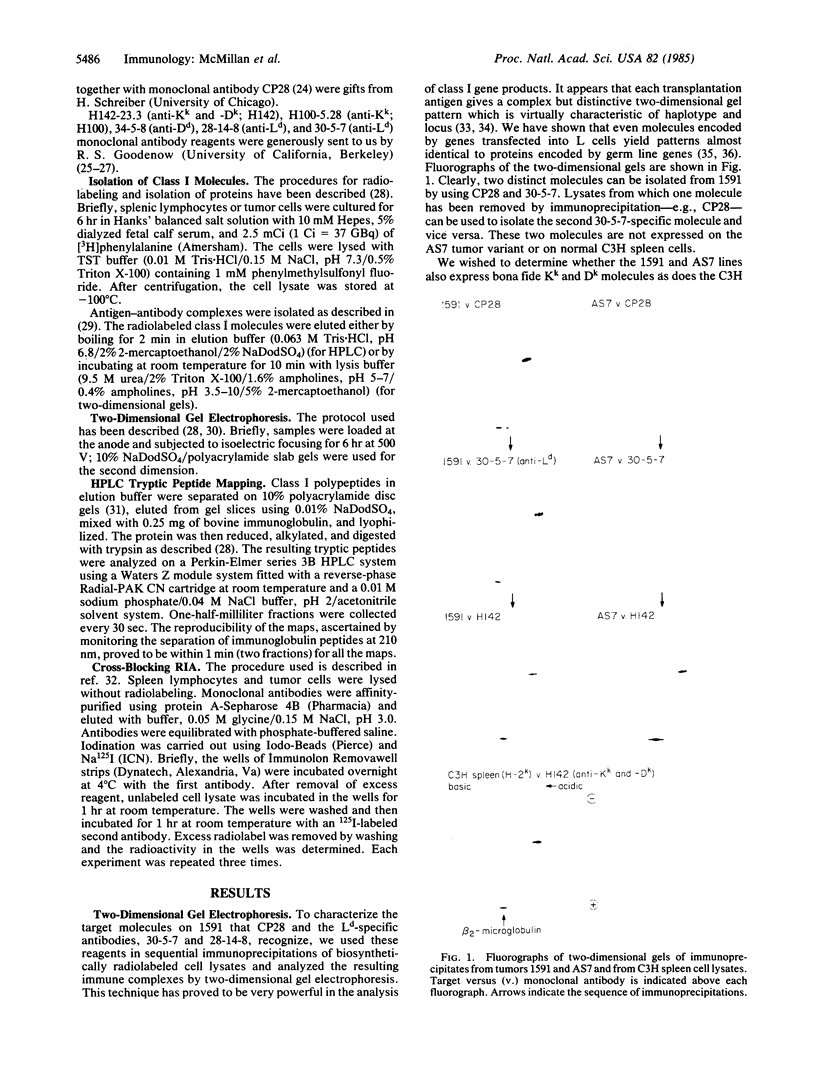
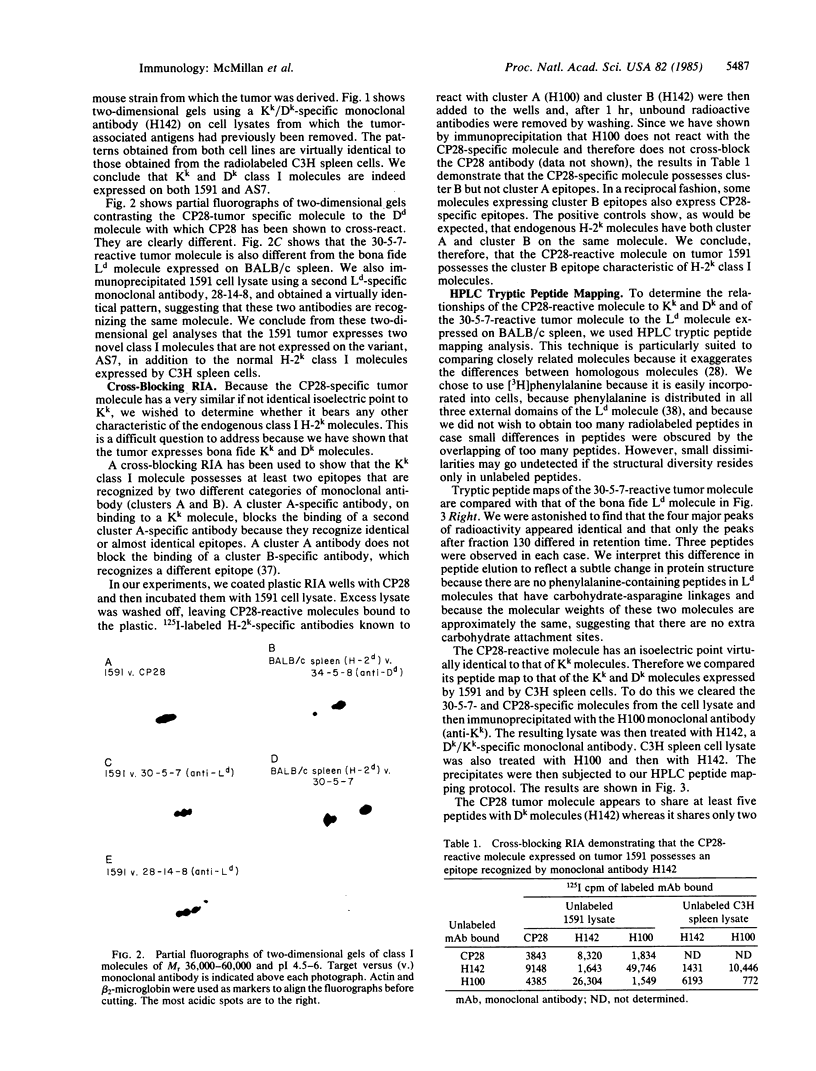
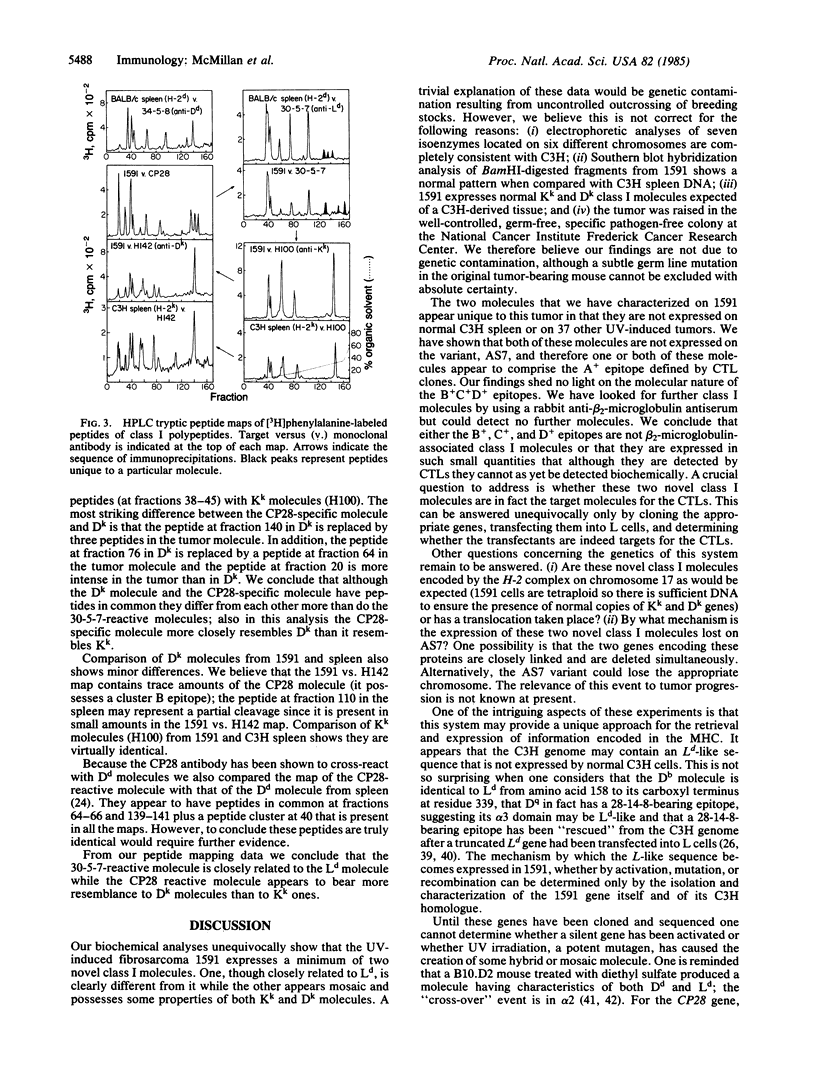
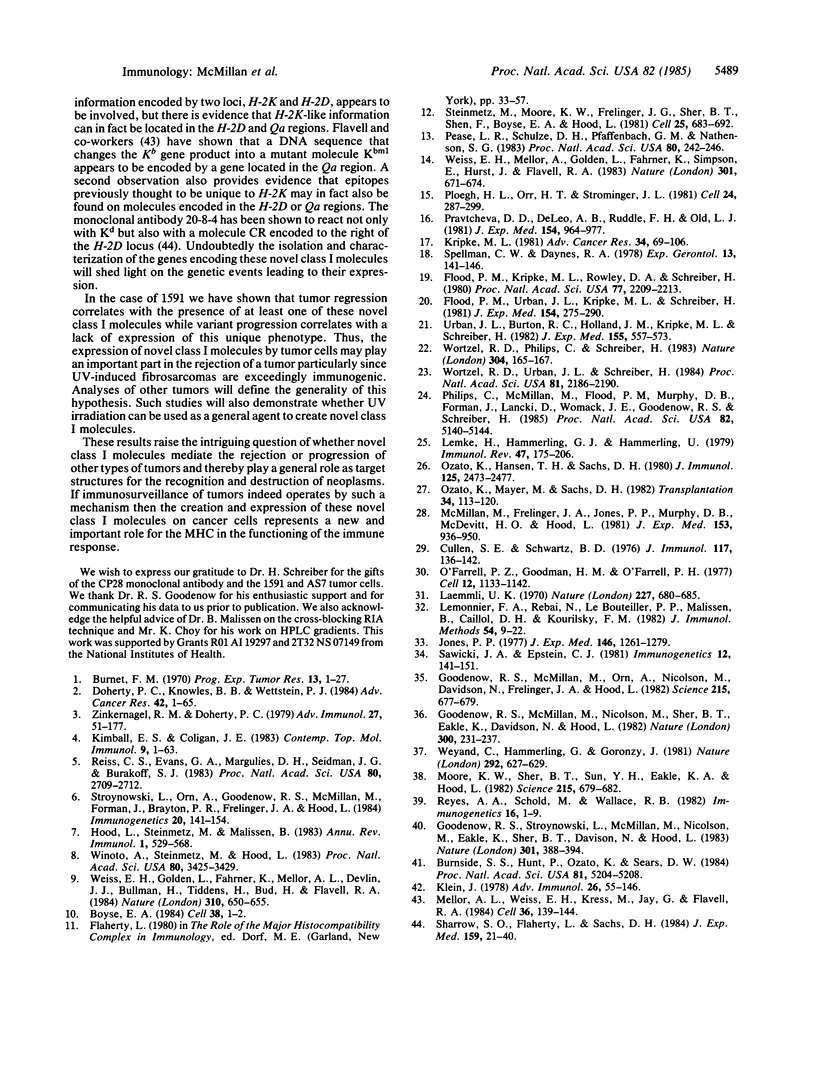
Images in this article
Selected References
These references are in PubMed. This may not be the complete list of references from this article.
- Boyse E. A. The biology of Tla. Cell. 1984 Aug;38(1):1–2. doi: 10.1016/0092-8674(84)90518-x. [DOI] [PubMed] [Google Scholar]
- Burnet F. M. The concept of immunological surveillance. Prog Exp Tumor Res. 1970;13:1–27. doi: 10.1159/000386035. [DOI] [PubMed] [Google Scholar]
- Burnside S. S., Hunt P., Ozato K., Sears D. W. A molecular hybrid of the H-2Dd and H-2Ld genes expressed in the dm1 mutant. Proc Natl Acad Sci U S A. 1984 Aug;81(16):5204–5208. doi: 10.1073/pnas.81.16.5204. [DOI] [PMC free article] [PubMed] [Google Scholar]
- Cullen S. E., Schwartz B. D. An improved method for isolation of H-2 and Ia alloantigens with immunoprecipitation induced by protein A-bearing staphylococci. J Immunol. 1976 Jul;117(1):136–142. [PubMed] [Google Scholar]
- Doherty P. C., Knowles B. B., Wettstein P. J. Immunological surveillance of tumors in the context of major histocompatibility complex restriction of T cell function. Adv Cancer Res. 1984;42:1–65. doi: 10.1016/s0065-230x(08)60455-8. [DOI] [PubMed] [Google Scholar]
- Flood P. M., Kripke M. L., Rowley D. A., Schreiber H. Suppression of tumor rejection by autologous anti-idiotypic immunity. Proc Natl Acad Sci U S A. 1980 Apr;77(4):2209–2213. doi: 10.1073/pnas.77.4.2209. [DOI] [PMC free article] [PubMed] [Google Scholar]
- Flood P. M., Urban J. L., Kripke M. L., Schreiber H. Loss of tumor-specific and idiotype-specific immunity with age. J Exp Med. 1981 Aug 1;154(2):275–290. doi: 10.1084/jem.154.2.275. [DOI] [PMC free article] [PubMed] [Google Scholar]
- Goodenow R. S., McMillan M., Nicolson M., Sher B. T., Eakle K., Davidson N., Hood L. Identification of the class I genes of the mouse major histocompatibility complex by DNA-mediated gene transfer. Nature. 1982 Nov 18;300(5889):231–237. doi: 10.1038/300231a0. [DOI] [PubMed] [Google Scholar]
- Goodenow R. S., McMillan M., Orn A., Nicolson M., Davidson N., Frelinger J. A., Hood L. Identification of a BALB/c H-2Ld gene by DNA-mediated gene transfer. Science. 1982 Feb 5;215(4533):677–679. doi: 10.1126/science.7058331. [DOI] [PubMed] [Google Scholar]
- Goodenow R. S., Stroynowski I., McMillan M., Nicolson M., Eakle K., Sher B. T., Davidson N., Hood L. Expression of complete transplantation antigens by mammalian cells transformed with truncated class I genes. Nature. 1983 Feb 3;301(5899):388–394. doi: 10.1038/301388a0. [DOI] [PubMed] [Google Scholar]
- Hood L., Steinmetz M., Malissen B. Genes of the major histocompatibility complex of the mouse. Annu Rev Immunol. 1983;1:529–568. doi: 10.1146/annurev.iy.01.040183.002525. [DOI] [PubMed] [Google Scholar]
- Jones P. P. Analysis of H-2 and Ia molecules by two-dimensional gel electrophoresis. J Exp Med. 1977 Nov 1;146(5):1261–1279. doi: 10.1084/jem.146.5.1261. [DOI] [PMC free article] [PubMed] [Google Scholar]
- Kimball E. S., Coligan J. E. Structure of class I major histocompatibility antigens. Contemp Top Mol Immunol. 1983;9:1–63. doi: 10.1007/978-1-4684-4517-6_1. [DOI] [PubMed] [Google Scholar]
- Klein J. H-2 mutations: their genetics and effect on immune functions. Adv Immunol. 1978;26:55–146. doi: 10.1016/s0065-2776(08)60229-1. [DOI] [PubMed] [Google Scholar]
- Kripke M. L. Immunologic mechanisms in UV radiation carcinogenesis. Adv Cancer Res. 1981;34:69–106. doi: 10.1016/s0065-230x(08)60239-0. [DOI] [PubMed] [Google Scholar]
- Laemmli U. K. Cleavage of structural proteins during the assembly of the head of bacteriophage T4. Nature. 1970 Aug 15;227(5259):680–685. doi: 10.1038/227680a0. [DOI] [PubMed] [Google Scholar]
- Lemke H., Hämmerling G. J., Hämmerling U. Fine specificity analysis with monoclonal antibodies of antigens controlled by the major histocompatibility complex and by the Qa/TL region in mice. Immunol Rev. 1979;47:175–206. doi: 10.1111/j.1600-065x.1979.tb00293.x. [DOI] [PubMed] [Google Scholar]
- Lemonnier F. A., Rebai N., Le Bouteiller P. P., Malissen B., Caillol D. H., Kourilsky F. M. Epitopic analysis of detergent-solubilized HLA molecules by solid-phase radioimmunoassay. J Immunol Methods. 1982 Oct 15;54(1):9–22. doi: 10.1016/0022-1759(82)90108-9. [DOI] [PubMed] [Google Scholar]
- McMillan M., Frelinger J. A., Jones P. P., Murphy D. B., McDevitt H. O., Hood L. Structure of murine Ia antigens. Two dimensional electrophoretic analyses and high pressure liquid chromatography tryptic peptide maps of products of the I-A and I-E subregions and of an associated invariant polypeptide. J Exp Med. 1981 Apr 1;153(4):936–950. doi: 10.1084/jem.153.4.936. [DOI] [PMC free article] [PubMed] [Google Scholar]
- Mellor A. L., Weiss E. H., Kress M., Jay G., Flavell R. A. A nonpolymorphic class I gene in the murine major histocompatibility complex. Cell. 1984 Jan;36(1):139–144. doi: 10.1016/0092-8674(84)90082-5. [DOI] [PubMed] [Google Scholar]
- Moore K. W., Sher B. T., Sun Y. H., Eakle K. A., Hood L. DNA sequence of a gene encoding a BALB/c mouse Ld transplantation antigen. Science. 1982 Feb 5;215(4533):679–682. doi: 10.1126/science.7058332. [DOI] [PubMed] [Google Scholar]
- O'Farrell P. Z., Goodman H. M., O'Farrell P. H. High resolution two-dimensional electrophoresis of basic as well as acidic proteins. Cell. 1977 Dec;12(4):1133–1141. doi: 10.1016/0092-8674(77)90176-3. [DOI] [PubMed] [Google Scholar]
- Ozato K., Hansen T. H., Sachs D. H. Monoclonal antibodies to mouse MHC antigens. II. Antibodies to the H-2Ld antigen, the products of a third polymorphic locus of the mouse major histocompatibility complex. J Immunol. 1980 Dec;125(6):2473–2477. [PubMed] [Google Scholar]
- Ozato K., Mayer N. M., Sachs D. H. Monoclonal antibodies to mouse major histocompatibility complex antigens. Transplantation. 1982 Sep;34(3):113–120. doi: 10.1097/00007890-198209000-00001. [DOI] [PubMed] [Google Scholar]
- Pease L. R., Schulze D. H., Pfaffenbach G. M., Nathenson S. G. Spontaneous H-2 mutants provide evidence that a copy mechanism analogous to gene conversion generates polymorphism in the major histocompatibility complex. Proc Natl Acad Sci U S A. 1983 Jan;80(1):242–246. doi: 10.1073/pnas.80.1.242. [DOI] [PMC free article] [PubMed] [Google Scholar]
- Philipps C., McMillan M., Flood P. M., Murphy D. B., Forman J., Lancki D., Womack J. E., Goodenow R. S., Schreiber H. Identification of a unique tumor-specific antigen as a novel class I major histocompatibility molecule. Proc Natl Acad Sci U S A. 1985 Aug;82(15):5140–5144. doi: 10.1073/pnas.82.15.5140. [DOI] [PMC free article] [PubMed] [Google Scholar]
- Ploegh H. L., Orr H. T., Strominger J. L. Major histocompatibility antigens: the human (HLA-A, -B, -C) and murine (H-2K, H-2D) class I molecules. Cell. 1981 May;24(2):287–299. doi: 10.1016/0092-8674(81)90318-4. [DOI] [PubMed] [Google Scholar]
- Pravtcheva D. D., DeLeo A. B., Ruddle F. H., Old L. J. Chromosome assignment of the tumor-specific antigen of a 3-methylcholanthrene-induced mouse sarcoma. J Exp Med. 1981 Sep 1;154(3):964–977. doi: 10.1084/jem.154.3.964. [DOI] [PMC free article] [PubMed] [Google Scholar]
- Reiss C. S., Evans G. A., Margulies D. H., Seidman J. G., Burakoff S. J. Allospecific and virus-specific cytolytic T lymphocytes are restricted to the N or C1 domain of H-2 antigens expressed on L cells after DNA-mediated gene transfer. Proc Natl Acad Sci U S A. 1983 May;80(9):2709–2712. doi: 10.1073/pnas.80.9.2709. [DOI] [PMC free article] [PubMed] [Google Scholar]
- Reyes A. A., Schöld M., Wallace R. B. The complete amino acid sequence of the murine transplantation antigen H-2Db as deduced by molecular cloning. Immunogenetics. 1982;16(1):1–9. doi: 10.1007/BF00364437. [DOI] [PubMed] [Google Scholar]
- Sawicki J. A., Epstein C. J. H-2 antigens as genetic markers: a two-dimensional gel electrophoretic study. Immunogenetics. 1981;12(1-2):141–151. doi: 10.1007/BF01561657. [DOI] [PubMed] [Google Scholar]
- Sharrow S. O., Flaherty L., Sachs D. H. Serologic cross-reactivity between Class I MHC molecules and an H-2-linked differentiation antigen as detected by monoclonal antibodies. J Exp Med. 1984 Jan 1;159(1):21–40. doi: 10.1084/jem.159.1.21. [DOI] [PMC free article] [PubMed] [Google Scholar]
- Spellman C. W., Daynes R. A. Immunoregulation by ultraviolet light-III. Enhancement of suppressor cell activity in older animals. Exp Gerontol. 1978;13(3-4):141–146. doi: 10.1016/0531-5565(78)90006-2. [DOI] [PubMed] [Google Scholar]
- Steinmetz M., Moore K. W., Frelinger J. G., Sher B. T., Shen F. W., Boyse E. A., Hood L. A pseudogene homologous to mouse transplantation antigens: transplantation antigens are encoded by eight exons that correlate with protein domains. Cell. 1981 Sep;25(3):683–692. doi: 10.1016/0092-8674(81)90175-6. [DOI] [PubMed] [Google Scholar]
- Stroynowski I., Orn A., Goodenow R. S., McMillan M., Forman J., Brayton P. R., Frelinger J., Hood L. Cytotoxic T lymphocytes recognize determinants on the BALB/c-H-2Ld molecule controlled by alpha 1 and alpha 2 but not alpha 3 external domains. Immunogenetics. 1984;20(2):141–154. doi: 10.1007/BF00364486. [DOI] [PubMed] [Google Scholar]
- Urban J. L., Burton R. C., Holland J. M., Kripke M. L., Schreiber H. Mechanisms of syngeneic tumor rejection. Susceptibility of host-selected progressor variants to various immunological effector cells. J Exp Med. 1982 Feb 1;155(2):557–573. doi: 10.1084/jem.155.2.557. [DOI] [PMC free article] [PubMed] [Google Scholar]
- Weiss E. H., Golden L., Fahrner K., Mellor A. L., Devlin J. J., Bullman H., Tiddens H., Bud H., Flavell R. A. Organization and evolution of the class I gene family in the major histocompatibility complex of the C57BL/10 mouse. Nature. 1984 Aug 23;310(5979):650–655. doi: 10.1038/310650a0. [DOI] [PubMed] [Google Scholar]
- Weiss E. H., Mellor A., Golden L., Fahrner K., Simpson E., Hurst J., Flavell R. A. The structure of a mutant H-2 gene suggests that the generation of polymorphism in H-2 genes may occur by gene conversion-like events. Nature. 1983 Feb 24;301(5902):671–674. doi: 10.1038/301671a0. [DOI] [PubMed] [Google Scholar]
- Weyand C., Hämmerling G. J., Goronzy J. Recognition of H-2 domains by cytotoxic T lymphocytes. Nature. 1981 Aug 13;292(5824):627–629. doi: 10.1038/292627a0. [DOI] [PubMed] [Google Scholar]
- Winoto A., Steinmetz M., Hood L. Genetic mapping in the major histocompatibility complex by restriction enzyme site polymorphisms: most mouse class I genes map to the Tla complex. Proc Natl Acad Sci U S A. 1983 Jun;80(11):3425–3429. doi: 10.1073/pnas.80.11.3425. [DOI] [PMC free article] [PubMed] [Google Scholar]
- Wortzel R. D., Philipps C., Schreiber H. Multiple tumour-specific antigens expressed on a single tumour cell. Nature. 1983 Jul 14;304(5922):165–167. doi: 10.1038/304165a0. [DOI] [PubMed] [Google Scholar]
- Wortzel R. D., Urban J. L., Schreiber H. Malignant growth in the normal host after variant selection in vitro with cytolytic T-cell lines. Proc Natl Acad Sci U S A. 1984 Apr;81(7):2186–2190. doi: 10.1073/pnas.81.7.2186. [DOI] [PMC free article] [PubMed] [Google Scholar]
- Zinkernagel R. M., Doherty P. C. MHC-restricted cytotoxic T cells: studies on the biological role of polymorphic major transplantation antigens determining T-cell restriction-specificity, function, and responsiveness. Adv Immunol. 1979;27:51–177. doi: 10.1016/s0065-2776(08)60262-x. [DOI] [PubMed] [Google Scholar]



